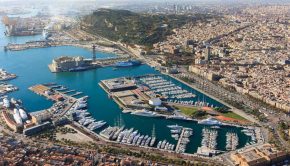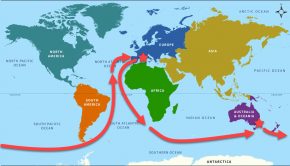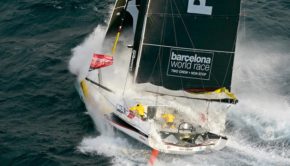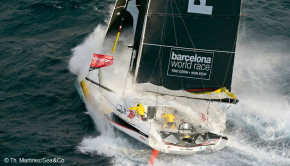BWR: Hurricane winds at Cape Horn
Published on March 11th, 2015
(March 11, 2015; Day 71) – On Day 70 of the Barcelona World Race, Jörg Riechers and Sébastien Audigane revealed that they encountered 70-knot gusts after rounding Cape Horn yesterday. Speaking in video conference today the Renault Captur skippers spoke of their relief at surviving what Audigane, who has now rounded the Horn four times, called “The most stressful conditions I have seen in 25 years.”
For German co-skipper Jörg Riechers, his first rounding of the landmark transpired to be the most severe Cape Horn crossing in the Barcelona World Race’s history.
“We survived it but it was not easy,” remarked Riechers. “Rounding Cape Horn was pretty easy. We had 35-40kts of wind. And just after the Cape, we thought OK, it is going to be easy. No stress. But one mile after Cape Horn came the first gust, 70kts of wind, so the boat was lying flat with the third reef in the main and the J3. So from there we were a bit scared, we bore away and rolled up the J3, and continued with the triple reefed mainsail. And still we surfed at 24 to 25kts. The seas were very white and very steep. In the end it was pretty scary. So for my first rounding of Cape Horn it was a big one.
“You are not super, super scared. But you ask yourself the questions. With a triple reefed main and with the boat on the edge of control, with the rudder problem, you can only steer with the autopilot, you just stay inside. You ask yourself what is going to happen if the autopilot freaks out and makes a mistake? Then you have a real, real big problem.”
The waiting game
Sébastien Audigane explained how the pair prepared for the storm and, once in its midst, rode it out together at the chart table in their survival suits:
“Two and a half days ago we contemplated turning round to avoid it. It was the perfect storm with a very low depression in the centre. Looking closely we judged we could pass it. But I confess that during the storm we looked at each other and said ‘This is a bullsh*t idea’. Once you are in it there is little you can do to manage the situation. The boat did well under three reefs. The only worry was our dear autopilot might give up on us.
“After the Horn, when we hit 70 knots and the wind was consistently at 60, we sat it out, watching what was going on outside from time to time as we waited at the chart table, ready to adjust the autopilot if needed. These are the most stressful conditions I have seen in 25 years.
“We don’t try to get ourselves into these situations. We had prepared the boat as best we could. We stacked the boat as best we could, we had our survival suits on and were ready psychologically.”
The boat was monitored constantly through the extreme conditions by the Race Direction team of the Barcelona World Race, liaising closely with the Chilean Navy and MRCC.
Tradewinds racing
At the front of the fleet, Cheminées Poujoulat has entered the North Atlantic tradewinds. Now just 2,600 miles from Barcelona, Bernard Stamm and Jean Le Cam have exited the Doldrums and are sailing in north-easterly winds of around 14 knots as they make miles to the north.
Second-placed Neutrogena, although some 1,300 miles to the south, has chipped another 100 miles off the leaders’ advantage, sailing consistently 1-2 knots faster than third placed GAES Centros Auditivos.
We Are Water and One Planet One Ocean Pharmaton have shadowed each other since rounding the Horn. This morning, however, the Garcia brothers on We Are Water were sailing at over 16-17 knots to One Planet One Ocean’s 12-13, and began pulling away from their long-term neighbours as they clocked up over 400 miles in 24 hours. This afternoon One Planet One Ocean Pharmaton are once again matching We Are Water for speed, with around 60 miles now between the two boats.
The real deal
The last remaining boat in the South Pacific, Spirit of Hungary, is approaching the edge of a large low pressure system that has seen them consistently sailing in 40-plus knots.
Conrad Colman blogged last night: “It feels a little lonely out here in the middle of the South Pacific, what with the rest of our fleet already around the Horn and the Volvo guys still tucked up in Auckland. For company we only have a monster depression centred south-east of us and directly on our route. At 2000 miles across and with a deep centre at 968 mb this is the real deal. We are broad reaching in a solid 40 knots with three reefs and the staysail, which feels pretty conservative, but when the 50 knot gusts roll through we wouldn’t want anything more up!”
Skippers’ quotes:
Jörg Riechers, Renault Captur:
We survived it. It was not easy. Now actually, all in all, it is good, we have 20kts and are reaching with the big gennaker, which we have not seen for a long time. We have clear skies. So it is a bit of a contrast between yesterday and today.
Rounding Cape Horn was pretty easy. We had 35-40kts of wind. And just after the Cape, we thought OK, it is going to be easy. No stress. But one mile after Cape Horn came the first gust, 70kts of wind, so the boat was lying flat with the third reef in the main and the J3. So from there we were a bit scared, we bore away and rolled up the J3, and continued with the triple reefed mainsail. And still we surfed at 24 to 25kts. The seas were very white and very steep. In the end it was pretty scary. So for my first rounding of Cape Horn it was a big one.
You are not super, super scared. But you ask yourself the questions. With a triple reefed main and with the boat on the edge of control, with the rudder problem, you can only s teer with the autopilot, you just stay inside. You ask yourself what is going to happen if the autopilot freaks out and makes a mistake? Then you have a real, real big problem.
That was a bit scary. Every 10 years a day like that is OK, but no more often than that. But today I am really pleased. We were slightly gutted with our race after the rudder issue. But in the end when you see it what you have achieved, for me first time, it’s such a big achievement. And continuing on after New Zealand and the rudder failure, we wanted to finish the race, we wanted to continue. It is an even better achievement. The result is not going to be what we wanted but the result will be an achievement in itself.
Sébastien Audigane, Renault Captur:
Five to six hours before Cape Horn we had the passage of the front with 55kts of wind and rough seas. It dropped away a bit. And then the depression arrived. It was very, very big which worried us a bit an d we had to get across in front of it. It was delayed a little, which let us pass Cape Horn in reasonable conditions. And then just after the point we got hit by the first gust of 70kts. We broached but managed to bear off with three reefs and triple reefed main. We waited a bit to roll away the J3 and after that we just had the triple reefed main for about 10 hours in pretty insane, crazy seas, not so big but just powerful, winds at 50-55kts and gusts to 65kts.
We found ourselves a bit jammed downwind with no alternative to sailing TWA 150 degrees, we could not luff without risking the boat. So we sailed downwind until the breeze backed and let us come up to pass east of Staten Island, which was the original plan. There we had very difficult seas. Now we are under gennaker.
Two and a half days ago we contemplated turning round to avoid it. It was the perfect storm with a very low depression in the centre. Looking closely we judged we could pass it. But I confess that during the storm we looked at each other and said “This is a bullsh*t idea”. Once you are in it there is little you can do to manage the situation. The boat did well under three reefs. The only worry was our dear autopilot might give up on us.
After the Horn, when we hit 70 knots and the wind was consistently at 60, we sat it out, watching what was going on outside from time to time as we waited at the chart table, ready to adjust the autopilot if needed. These are the most stressful conditions I have seen in 25 years.
We don’t try to get ourselves into these situations. We had prepared the boat as best we could. We stacked the boat as best we could, we had our survival suits on and were ready psychologically.
Afterwards, all was well. We had a good meal to celebrate, we were finally able to relax a little bit. I think all our nervous energy was released as we were super-tired last night, but we got some goo d rest in watches.
Having been through these conditions it gives you a bit more additional experience to enable you to keep your cool in more extreme conditions. But it went well. We are not crazy and we had measured the risks.
Conrad Colman, Spirit of Hungary:
It feels a little lonely out here in the middle of the South Pacific, what with the rest of our fleet already around the Horn and the Volvo guys still tucked up in Auckland. For company we only have a monster depression centred south-east of us and directly on our route. At 2000 miles across and with a deep centre at 968 mb this is the real deal. We are broad reaching in a solid 40 knots with three reefs and the staysail, which feels pretty conservative, but when the 50 knot gusts roll through we wouldn’t want anything more up!
When we round the Horn in a few days time it will be because we escaped, not because we conquered the craziest race course in the world. We just passed underneath Point Nemo, the most isolated place on earth. Even the International Space Station is closer to land than we are, at only a few hundred kilometres up!
Ranking at 14:00 UTC:
1. Cheminées Poujoulat (Bernard Stamm – Jean Le Cam) 2712.2 nm Distance to Finish
2. Neutrogena (Guillermo Altadill – Jose Muñoz) 1342.9 nm Distance to Lead
3. GAES Centros Auditivos (Anna Corbella – Gerard Marin) 1544.1 nm DTL
4. We Are Water (Bruno Garcia – Willy Garcia) 3019.1 nm DTL
5. One Planet One Ocean / Pharmaton (Aleix Gelabert – Didac Costa) 3067.0 nm DTL
6. Renault Captur (Jörg Riechers – Sebastien Audigane) 3840.3 nm DTL
7. Spirit of Hungary (Nandor Fa – Conrad Colman) 5643.8 nm DTL
Hugo Boss (Alex Thomson – Pepe Ribes) Abandon
Report by event media.
Background: The third edition of the Barcelona World Race is the only double-handed, non-stop, round the world race. Eight IMOCA 60 teams started December 31, 2014, with the intent to cover 23,450 nautical miles in a circumnavigation from Barcelona to Barcelona, putting the capes of Good Hope (South Africa), Leeuwin (Australia) and Horn (Chile) to port and the Antarctic to starboard. The finishes are forecasted for the end of March 2015.









 We’ll keep your information safe.
We’ll keep your information safe.